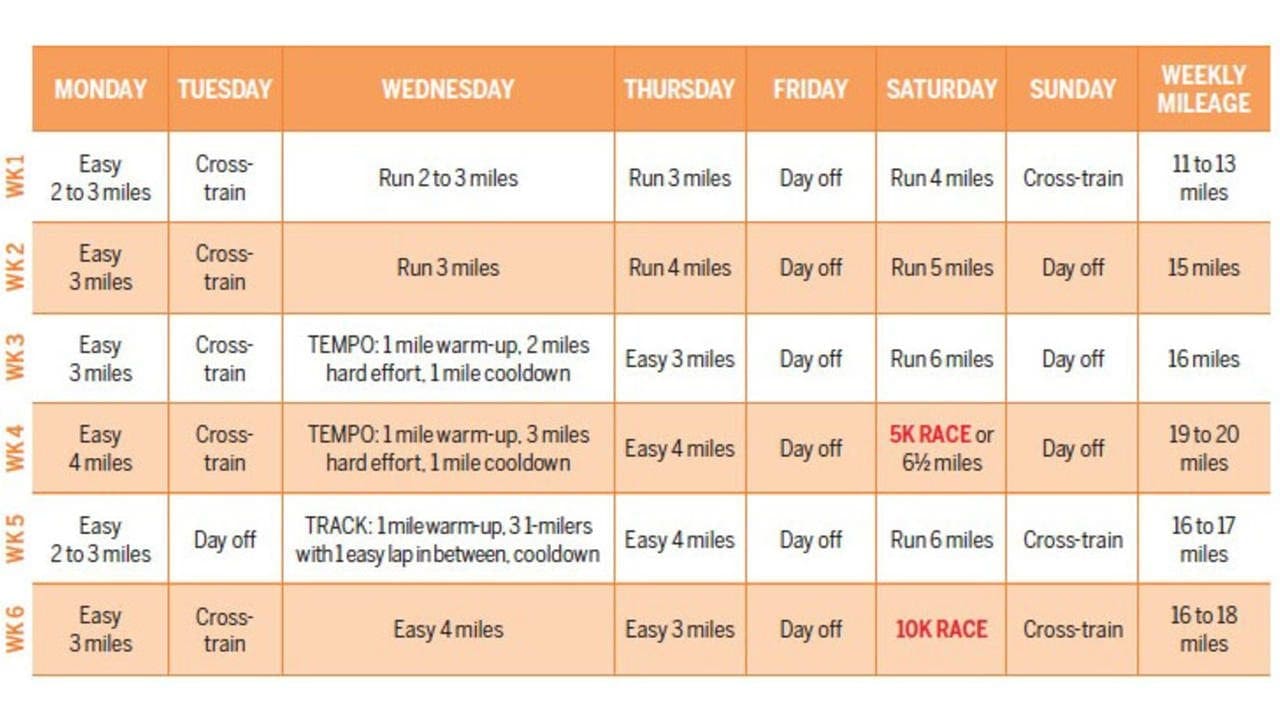Thinking of training for a 10K race? This plan is perfect for you if you’ve already mastered a 5K race and you’re a “sometimes” runner who is able to do at least three miles without stopping a couple of days a week, most weeks. The goal for this 10K training plan, which was developed by developed by running coach Paula Harkin, co-owner of Portland Running Company in Oregon, will be to increase your endurance, run for an hour straight, and tackle a 10K by the end of 6 weeks.
RELATED: The 50 Most Gorgeous Running Races in America, State by State
The 10K training plan: This program incorporates a combo of tempo (effort of 7 or 8 on a scale of 1 to 10), and longer runs (effort of 5 or 6 ) to build endurance. “Combining these workouts will help you get faster while also making sure you can cover the distance,” says Harkin. Do a combination of running and cross-training on alternate days. As the weeks pass, alternate between building up the speed bursts and balancing out the recovery time. Focus on covering the distance, not your pace. Kick off with an easy 2 to 3 mile run. Over 6 weeks, try to work up to running 6 miles.

How to train smarter for your 10K race
1. Make three the magic number. If you’re used to running twice a week, says Jonathan Cane, an exercise physiologist and co-founder of City Coach Multisport in New York City, “three times is your sweet spot�. You’ll get a big bump in both speed and endurance, but it’s not so much more that you’ll risk getting injured.” And if weight loss is a goal, remember that adding just one extra day of running helps you burn an additional 300 to 400 calories, depending on your pace and size.
2. It’s OK to hit the treadmill. Some running purists say there’s no substitute for the outdoors, but all things being equal, “your heart and lungs don’t really know the difference between the road and the treadmill,” says Cane. So if it’s late in the day, raining or just not a good time to go outside but you really want to keep up your training, feel free to hit the “on” button. To compensate for a lack of wind resistance and natural terrain changes, keep the treadmill deck set at a 1% incline.
3. Turn down the music. Yes, pumping JT through your earbuds can power you up that hill, but don’t forget to tune in to how your body feels. “At this stage, you know you can already run for a while,” says Cane. “But it’s important to be aware of cues: how heavy you are breathing, or if you have a small twinge in your knee and need to slow down. It helps keep you from getting injured and makes you more aware of when you can bump up your pace or give a little more effort.”
For more information, please feel free to ask Dr. Jimenez or contact us at 915-850-0900 .
Chiropractic and Athletic Performance
Many athletes who are injured performing their specific sport or physical activity, frequently seek treatment from chiropractors. Chiropractic care focuses on the prevention, diagnosis and treatment of injuries and conditions affecting the musculoskeletal and nervous system. While chiropractic is a safe and effective form of conservative care for a variety of ailments, chiropractic can also be utilized to enhance athletic performance.
TRENDING TOPIC: EXTRA EXTRA: New PUSH 24/7�? Fitness Center
General Disclaimer, Licenses and Board Certifications *
Professional Scope of Practice *
The information herein on "Preparation & Training for a 10K Race" is not intended to replace a one-on-one relationship with a qualified health care professional or licensed physician and is not medical advice. We encourage you to make healthcare decisions based on your research and partnership with a qualified healthcare professional.
Blog Information & Scope Discussions
Welcome to El Paso's Premier Wellness and Injury Care Clinic & Wellness Blog, where Dr. Alex Jimenez, DC, FNP-C, a Multi-State board-certified Family Practice Nurse Practitioner (FNP-BC) and Chiropractor (DC), presents insights on how our multidisciplinary team is dedicated to holistic healing and personalized care. Our practice aligns with evidence-based treatment protocols inspired by integrative medicine principles, similar to those on this site and on our family practice-based chiromed.com site, focusing on naturally restoring health for patients of all ages.
Our areas of multidisciplinary practice include Wellness & Nutrition, Chronic Pain, Personal Injury, Auto Accident Care, Work Injuries, Back Injury, Low Back Pain, Neck Pain, Migraine Headaches, Sports Injuries, Severe Sciatica, Scoliosis, Complex Herniated Discs, Fibromyalgia, Chronic Pain, Complex Injuries, Stress Management, Functional Medicine Treatments, and in-scope care protocols.
Our information scope is multidisciplinary, focusing on musculoskeletal and physical medicine, wellness, contributing etiological viscerosomatic disturbances within clinical presentations, associated somato-visceral reflex clinical dynamics, subluxation complexes, sensitive health issues, and functional medicine articles, topics, and discussions.
We provide and present clinical collaboration with specialists from various disciplines. Each specialist is governed by their professional scope of practice and their jurisdiction of licensure. We use functional health & wellness protocols to treat and support care for musculoskeletal injuries or disorders.
Our videos, posts, topics, and insights address clinical matters and issues that are directly or indirectly related to our clinical scope of practice.
Our office has made a reasonable effort to provide supportive citations and has identified relevant research studies that support our posts. We provide copies of supporting research studies upon request to regulatory boards and the public.
We understand that we cover matters that require an additional explanation of how they may assist in a particular care plan or treatment protocol; therefore, to discuss the subject matter above further, please feel free to ask Dr. Alex Jimenez, DC, APRN, FNP-BC, or contact us at 915-850-0900.
We are here to help you and your family.
Blessings
Dr. Alex Jimenez DC, MSACP, APRN, FNP-BC*, CCST, IFMCP, CFMP, ATN
email: coach@elpasofunctionalmedicine.com
Multidisciplinary Licensing & Board Certifications:
Licensed as a Doctor of Chiropractic (DC) in Texas & New Mexico*
Texas DC License #: TX5807, Verified: TX5807
New Mexico DC License #: NM-DC2182, Verified: NM-DC2182
Multi-State Advanced Practice Registered Nurse (APRN*) in Texas & Multi-States
Multi-state Compact APRN License by Endorsement (42 States)
Texas APRN License #: 1191402, Verified: 1191402 *
Florida APRN License #: 11043890, Verified: APRN11043890 *
License Verification Link: Nursys License Verifier
* Prescriptive Authority Authorized
ANCC FNP-BC: Board Certified Nurse Practitioner*
Compact Status: Multi-State License: Authorized to Practice in 40 States*
Graduate with Honors: ICHS: MSN-FNP (Family Nurse Practitioner Program)
Degree Granted. Master's in Family Practice MSN Diploma (Cum Laude)
Dr. Alex Jimenez, DC, APRN, FNP-BC*, CFMP, IFMCP, ATN, CCST
My Digital Business Card
Licenses and Board Certifications:
DC: Doctor of Chiropractic
APRNP: Advanced Practice Registered Nurse
FNP-BC: Family Practice Specialization (Multi-State Board Certified)
RN: Registered Nurse (Multi-State Compact License)
CFMP: Certified Functional Medicine Provider
MSN-FNP: Master of Science in Family Practice Medicine
MSACP: Master of Science in Advanced Clinical Practice
IFMCP: Institute of Functional Medicine
CCST: Certified Chiropractic Spinal Trauma
ATN: Advanced Translational Neutrogenomics
Memberships & Associations:
TCA: Texas Chiropractic Association: Member ID: 104311
AANP: American Association of Nurse Practitioners: Member ID: 2198960
ANA: American Nurse Association: Member ID: 06458222 (District TX01)
TNA: Texas Nurse Association: Member ID: 06458222
NPI: 1205907805
| Primary Taxonomy | Selected Taxonomy | State | License Number |
|---|---|---|---|
| No | 111N00000X - Chiropractor | NM | DC2182 |
| Yes | 111N00000X - Chiropractor | TX | DC5807 |
| Yes | 363LF0000X - Nurse Practitioner - Family | TX | 1191402 |
| Yes | 363LF0000X - Nurse Practitioner - Family | FL | 11043890 |









